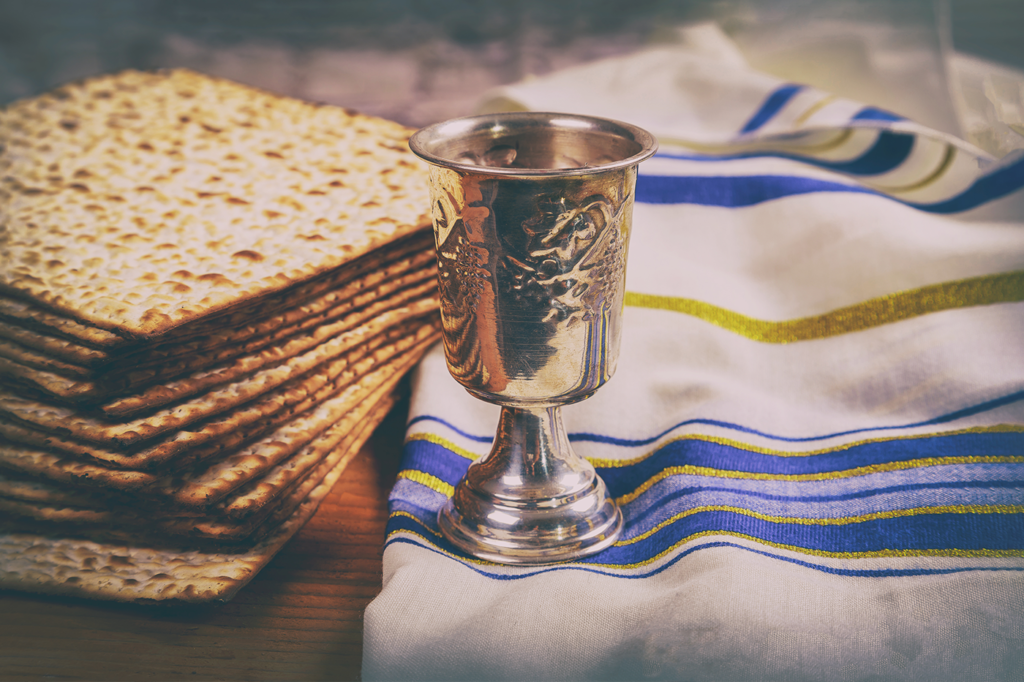This week, Jews and Christians around the world are celebrating some of the holiest and most joyous days in our respective liturgical calendars. Due to COVID-19, this year we’ve all labored under more disruptive conditions. The customary family gatherings, late-night vigils and early-morning Masses, and the uniquely participatory meal replete with biblical and rabbinic readings, known as the Passover Seder, took place in more solitary settings—when they took place at all. But one annual pre-Passover rite of passage in my home went ahead totally unimpeded by the pandemic.
Every year as Passover approaches, I purchase a new Haggadah, the canonical text, playbook, teaching aid, and script, all in one, for the upcoming Seder. The challenge is to find some new commentary, literary twist, or other novelty to help keep the traditional rite fresh and engaging for all ages gathered around the table—let’s be candid, myself included. Past years’ purchases have included Haggadahs with running commentary of Rabbi Joseph B. Soloveitchik or Rabbi Jonathan Sacks; ones illustrated with the sacrificial rites and details of the actual Temple service in ancient Jerusalem; or some other layer of interpretation to place on the sturdy structure of a roughly two-thousand-year-old document, repeated each Passover (I’m slightly embarrassed, so I’ll blame it on my oldest daughter: one year it was the Hogwarts Haggadah).
With this in mind, you can imagine the excited curiosity—mixed with caution, of course—that swept over me upon discovering the Passover Haggadah Graphic Novel, handsomely illustrated by Erez Zadok and created by Jordan B. Gorfinkel, a former manager of the Batman franchise at DC Comics. A careful exegesis of this latest fix in my Haggadah habit would richly reward the reader, both new and old to the Seder. Not only does the Passover Haggadah Graphic Novel offer arresting illustrations to go with a beloved text, but in places it actually advances the meaning of this most familiar liturgy, deepening the experience for the most faithful participant in the Passover rite. One example will have to suffice, but this idea arguably gets to the theological core of the entire Seder, something both Jews and Christians can profitably learn from, especially this year.
Just a few pages into the central portion of the Haggadah, the part that actually tells the story of the Exodus of the Children of Israel from Egypt, Jews collectively recite (or, more routinely, sing) the following: Blessed is He Who keeps His promise to Israel, may He be blessed, before invoking the biblical prophecy to Abraham some four hundred years earlier known as the Covenant Between the Pieces (Genesis 15:7–21) that predicted both the Egyptian exile and the miraculous redemption. In illustrating the verses from Genesis in which G-d says to Abraham, “You must know that your descendants will have to live in a foreign country . . . whose people will enslave and oppress them for four hundred years. But I will pass judgment on that nation and then they will leave with great wealth,” Zadok portrays a triptych of scenes to show the continuity between the oppression in Ancient Egypt, alternating with the Nazi atrocities of the last century, followed by Adolph Eichmann’s trial in Jerusalem in 1961–2 (“but I will pass judgment on that nation”), and culminating in the celebration by proud grandparents of the circumcision of a baby Jewish boy in contemporary times (“and then they leave with great wealth”), giving graphic expression to the cycle of oppression and redemption that so powerfully marks Jewish history.
Continuing this theme of providential intercession, the Haggadah proceeds to a rousing song of salvation, beginning with the words And this [promise of the Covenant Between the Pieces] is what has stood by our ancestors and us, and ending for it was not only one man who rose up to destroy us: in every single generation people rise up to destroy us—but the Holy One saves us from their hands. Here, Zadok cleverly creates a rogue’s gallery of historical enemies of the Jewish people, going beyond the portrayal of the Nazi nemesis, to include both ancient foes like Egyptians and Romans, and modern-era oppressors like Soviet-era apparatchiks and masked Jihadists.
Start your day with Public Discourse
Sign up and get our daily essays sent straight to your inbox.Here the graphic novel genre is at its best, giving tangible expression to concepts familiar to every Seder participant over the millennia. But as effective as this graphic comic depiction may be, none of it is necessarily new. I remember growing up in Queens over forty years ago with a lavishly illustrated Haggadah, which similarly portrayed the Jews’ foes in this stanza. True, the new Passover Haggadah Graphic Novel does a better job aesthetically, but it doesn’t necessarily break new ground. So, what happened to make this night different from all other nights?
Here’s the innovation: for the first time in my Haggadah reading and leading history, I fully grasped the sweeping implications of the promise implied in the Covenant Between the Pieces. Now the unstated object of the Haggadah’s indexical reference “And this”—which or what “this”?—became abundantly clear. It was this very promise of the Covenant Between the Pieces that “had stood by our ancestors and for us,” namely, that the promise of both oppression and redemption was not merely a one-time occurrence, an oath to Father Abraham exhausted by the Egyptian Exodus, never to be repeated again.
No, this was a perennial promise, with elements of painful oppression and beatific salvation, made to the Jewish people for all time. Egypt is not a relic of ancient history or, in a different rendering, a typological event to be realized at one particular time and place but no more. Instead, it’s a transhistorical reality, both a marker of objective and ongoing earthly occurrences and subjective states of spiritual confinement and constriction.
What kind of deity can make such a promise, one not only of raw power but of timeless and loving empathy? Surely no god the world had seen before Abraham’s family arrived on the historical scene. At Moses’s first encounter with G-d on Mount Horeb, there’s no getting around this question of divine identity: “Behold, when I come to the Children of Israel and say to them, the G-d of your forefathers has sent me to you, and they say to me, What is His Name?—what shall I say to them?” (Exodus 3:13). In other words, Moses is wondering if the oppressed Jewish masses will have confidence that their G-d will be understood or accepted by Pharaoh—or themselves, for that matter—as anything more than another Near Eastern deity, powerful but ultimately parochial? What is G-d’s name, really? What is the most elemental attribute, and, perhaps going beyond even attributes and descriptions, what is G-d’s proper name?
This is G-d’s answer to Moses’s request: I Shall Be As I Shall Be. And He said, So Shall you say to the Children of Israel, I Shall Be has sent me to you (Exodus 3:14). The Hebrew original, Ayeh Asher Ayeh, also contracted into the more familiar Hebrew name we sometimes sloppily transliterate as Jehovah, suggests not the traditional scholastic reading of Ultimate Being or Essence, but a rather more dynamic, transitive reality, reflecting the Hebrew words for past, present, and future in simultaneity. (Even as learned a Jew as Leo Strauss got this wrong, but I suspect there was a larger dynamic at play, best saved for another day.)
To put things more plainly, the G-d of Abraham, Isaac, and Jacob, is not only historical, and historically guilty of the scandal of particularity, but is insisting on His loving relationship with His firstborn child (Exodus 4:22) and, by His identity as a transhistorical Creator, with all His creatures through empathy and engagement, throughout time. As the traditional eleventh-century, French-German exegete Rashi puts it, “The Divine Name ‘I Shall Be’ suggests His relationship to the sufferer, ‘I shall be with them in this sorrow as I shall be with them in other sorrows.’” This is precisely the kind of loving G-d of compassion and constancy foreshadowed at the Covenant Between the Pieces and annually reconfirmed at Seder tables around the world.
In these difficult days and days of COVID-19, can’t we all, Jews and Gentiles, be comforted by this teaching so central to Passover—and, at the risk of some syncretism, Easter? Our Loving Father is asking us to remember His promise: “I am with you now, as I was with you before this plague and as I will be with you after this plague, helping you rise out of the confines of whatever hell you are living in.” As brothers and sisters, separately but together, we can raise our cups of wine and rejoice. And this is what has stood by our ancestors and us, for it was not only one enemy that rose up to destroy us. “In every single generation, forces rise up to destroy us—but the Holy One saves us from their hand.” With G-d’s help again, it will be so. Next Year in Jerusalem!














